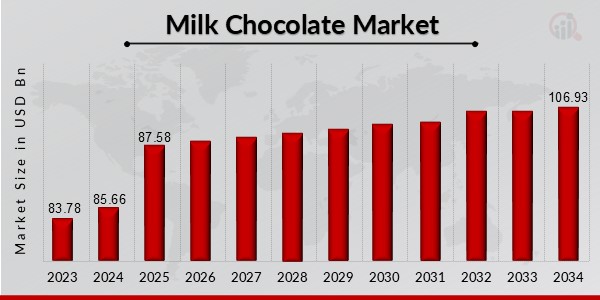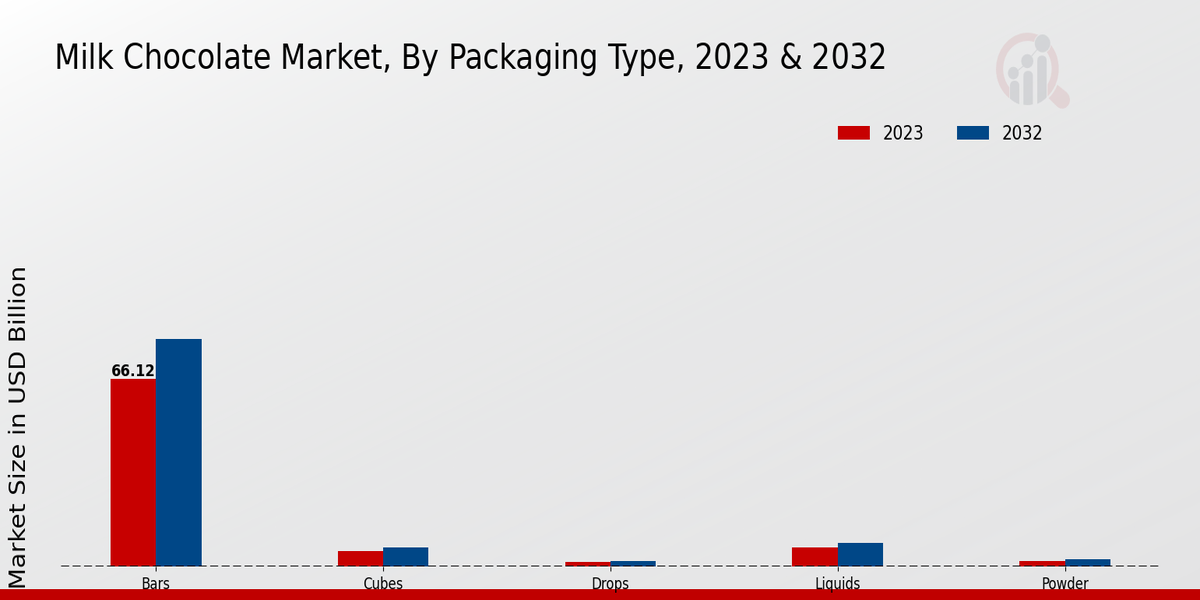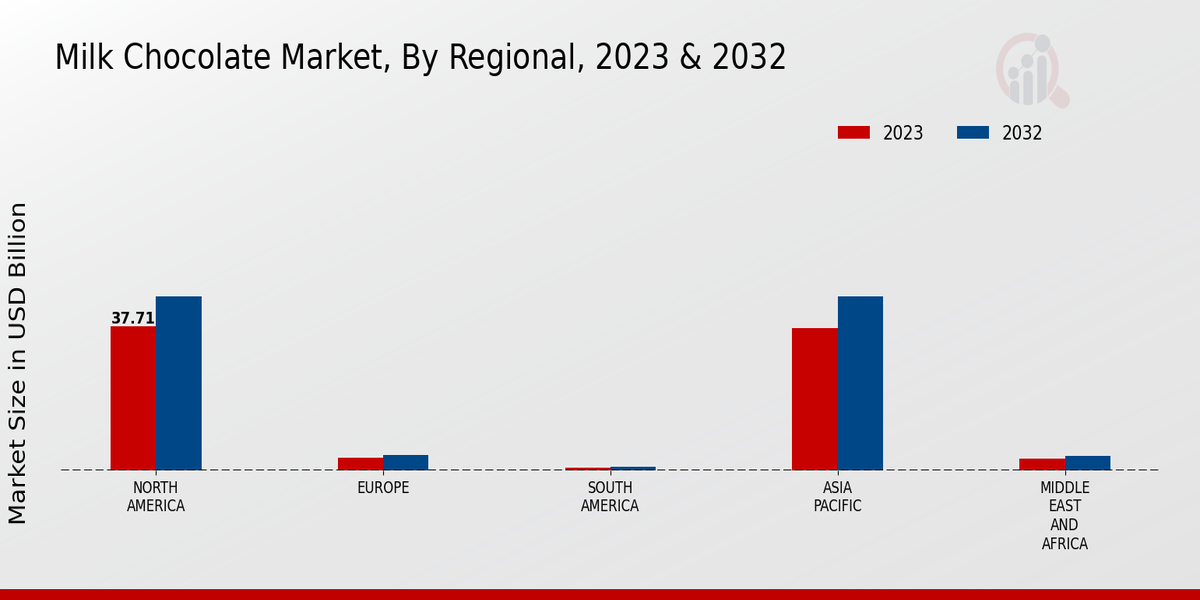Global Milk Chocolate Market Overview
Milk Chocolate Market Size was estimated at 85.66 (USD Billion) in 2024. The Milk Chocolate Industry is expected to grow from 87.58(USD Billion) in 2025 to 106.93(USD Billion) by 2034. The Milk Chocolate Market CAGR (growth rate) is expected to be around 2.2% during the forecast period (2025-2034).

Source: Primary Research, Secondary Research, MRFR Database and Analyst Review
Key Milk Chocolate Market Trends Highlighted
The global market for milk chocolate is witnessing a surge in demand, driven by rising disposable incomes, changing consumer preferences, and increased urbanization. The growing popularity of premium and indulgent chocolate varieties has created opportunities for manufacturers to offer differentiated products that cater to consumer desires for rich and flavorful experiences.Sustainability and ethical sourcing are emerging as key market trends, with consumers becoming increasingly conscious of the environmental and social impact of their purchases. This has led to a growing demand for certified and sustainable milk chocolate products. Additionally, the rise of e-commerce has expanded the reach of milk chocolate manufacturers, enabling them to connect with consumers across borders and offer personalized shopping experiences.
Milk Chocolate Market Drivers
Growing Health Consciousness Among Consumers
With the growing health consciousness among the consumers, there has been increasing demand for healthier alternatives to the traditional snacks and desserts. Milk chocolate is considered a healthier option among the different types of chocolate which is driving the demand for milk chocolate. Milk chocolate is a valuable source of calcium, protein and other essential nutrients that are known to be beneficial to human health . Naturally, the consumers would prefer such alternatives to chocolate.The existing trend and also the growing awareness about the health benefits of milk chocolate would continue to increase demand for milk chocolate in the years to come.
Rising Disposable Income and Changing Lifestyles
The increasing disposal income of consumers and changing lifestyle of people in the developing nations are also the factors which are increasing the demand of the milk chocolate market. The consumers are spending more on premium and indulgent products as they have disposal income. Moreover, they are moving towards the on the go snacks and convenience foods due growing busy lifestyles which is also increasing the demand of the milk chocolates.
Expansion of Retail and Distribution Channels
Another vital factor driving the expansion of the Milk Chocolate Market Industry is the increasing retail and distribution channel. The availability of milk chocolate in supermarkets and hypermarkets, as well as vending machines and convenience stores, is increasing the accessibility of milk chocolate to consumers. In addition, the rising trend of online shopping is enabling consumers to purchase milk chocolate online.
Milk Chocolate Market Segment Insights
Milk Chocolate Market Packaging Type Insights
Packaging Type Segment Insights and Overview The Milk Chocolate Market is segmented into various packaging types, including bars, cubes, drops, liquids, and powder, each catering to specific consumer preferences and distribution channels. Bars: Bars are the most popular packaging type, accounting for a significant share of the Milk Chocolate Market revenue. They offer convenience, ease of consumption, and portability, making them suitable for on-the-go snacking and impulse purchases. Cubes: Milk chocolate cubes provide a visually appealing and premium experience.They are often sold in luxury packaging and are targeted at discerning consumers seeking a sophisticated treat. Cubes account for a smaller but growing segment of the market, driven by increasing demand for premium chocolate products. Drops: Milk chocolate drops are small, bite-sized pieces that offer flexibility in usage. They can be used as toppings, decorations, or baking ingredients, appealing to home bakers and culinary professionals. The drops segment is expected to witness steady growth as consumers seek versatile and convenient chocolate options.Liquids: Liquid milk chocolate is a relatively niche segment but offers unique applications in beverages, desserts, and sauces. It is popular in the foodservice industry and among consumers seeking a rich and indulgent chocolate experience. Powder: Milk chocolate powder is a versatile ingredient used in baking, confectionery, and beverage preparations. It is a cost-effective option and caters to the needs of commercial food manufacturers and home bakers alike. The Milk Chocolate Market is witnessing a rise in demand for sustainable and eco-friendly packaging solutions.Consumers are increasingly seeking products that align with their environmental values, driving manufacturers to adopt biodegradable and recyclable packaging materials. This trend is expected to shape the packaging type landscape in the coming years.

Source: Primary Research, Secondary Research, MRFR Database and Analyst Review
Milk Chocolate Market Cocoa Content Insights
The cocoa content segment plays a crucial role in the Milk Chocolate Market segmentation. In 2023, the medium-cocoa segment (35-60%) held the largest market share, accounting for around 43.1% of the Milk Chocolate Market revenue. This dominance can be attributed to the wide range of applications of medium-cocoa milk chocolate in confectionery products, bakery items, and beverages. The Milk Chocolate Market data indicates a steady growth in the demand for high-cocoa milk chocolate (>60%) due to increasing consumer preference for premium and dark chocolates, especially in developed regions.In 2024, the high-cocoa segment is projected to witness a CAGR of 3.2%, driven by rising health and the growing popularity of sugar-free and low-calorie chocolate options.
Milk Chocolate Market Flavor Insights
The Flavor segment of the Milk Chocolate Market is categorized into Plain, Fruit-flavored, Nut-flavored, Caramel-flavored, and Toffee-flavored. Among these, Plain accounts for the largest market share due to its classic taste and wide acceptance. Fruit-flavored milk chocolate is gaining popularity, particularly among younger consumers, driven by its fruity and refreshing taste profiles. Nut-flavored milk chocolate is another popular variant, offering a rich and nutty taste experience. Caramel-flavored and Toffee-flavored milk chocolates are also gaining traction, appealing to consumers seeking indulgent and flavorful options.The Milk Chocolate Market revenue for the Flavor segment is projected to reach USD 12.5 billion by 2028, exhibiting a steady growth rate over the forecast period.
Milk Chocolate Market Distribution Channel Insights
The distribution channel segment plays a crucial role in the Milk Chocolate Market. Supermarkets/Hypermarkets dominate the market, accounting for a significant share of Milk Chocolate Market revenue. Their vast product offerings, convenient locations, and established customer base contribute to their dominance. Convenience stores also hold a notable market share, catering to consumers seeking quick and easy access to Milk Chocolate products. Online retailers are gaining traction, offering a wide selection, competitive pricing, and home delivery convenience.Specialty stores, focused on premium and niche Milk Chocolate offerings, target discerning consumers. Pharmacies offer a limited selection of Milk Chocolate products, primarily targeting consumers seeking health-conscious options.
Milk Chocolate Market Regional Insights
The Milk Chocolate Market is segmented into North America, Europe, Asia Pacific, South America, and the Middle East and Africa. North America is the largest regional market, followed by Europe and Asia Pacific. The North American market is mature, while the Asia Pacific market is expected to grow at the highest CAGR during the forecast period. Some key market insights include: The Asia Pacific region is expected to witness significant growth due to the increasing demand for chocolate in emerging countries such as China and India. Europe is the second-largest regional market for milk chocolate, with a well-established chocolate industry.The Middle East and Africa region is expected to have a steady growth rate due to the growing population and increasing disposable income. The key market players in the Milk Chocolate Market include Mars Incorporated, Mondelez International, Nestlé, and Hershey's. The Milk Chocolate Market is segmented based on product type, distribution channel, and region. .

Source: Primary Research, Secondary Research, MRFR Database and Analyst Review
Milk Chocolate Market Key Players And Competitive Insights
Leading Milk Chocolate Market industry players are adopting new strategies to target the changing consumer trends. For instance, in 2023, Mars Incorporated launched a new line of milk chocolate, Mars Edge, targeting consumers seeking a more indulgent and sophisticated chocolate experience. In addition, other leading Milk Chocolate Market industry players, such as Mondelēz International and Nestlé are expanding their product ranges by launching new milk chocolate flavors and brands to attract new customers. Moreover, the Milk Chocolate Market is witnessing robust development on account of the increasing demand for premium and artisanal chocolate. Specifically, potential avenues of growth are emerging from the trend among a growing number of consumers to pay more for high-quality and distinctive products.
Mars Incorporated is a major market player in the Milk Chocolate Market. The company boasts of an extensive global footprint and a wide variety of popular and established chocolate brands such as M’s, Snickers, and Twix. Notably, Mars Inc. is highly regarded for its continuous innovation and development of new products and marketing strategies, which is attributed to the company’s continued success in the market. In addition, the company puts a high premium on research and development, and it frequently introduces new products to cater for the changing consumer needs. Furthermore, Mars Inc. has a well-developed distribution network, which extends to diverse outlets including grocery stores, supermarkets, cafés and bakeries, and online channels, enabling the company to reach a high number of consumers.Fererro Group, which has a strong global presence, is a significant player in the Milk Chocolate Market. The company is renowned for its leading chocolate brands, including Nutella, Kinder, and Tic Tac, among others. Notably, Fererro has a strong innovation strategy and is constantly developing new products in response to the changing market needs. In addition, the company has a wide distribution network and its products are sold in over 170 countries._regeneration.
Key Companies in the Milk Chocolate Market Include
- Toblerone
- Godiva
- Ferrero Roche Group
- Hershey
- Milka
- Cadbury
- Mars
- Nestlé
Milk Chocolate Market Industry Developments
The Milk Chocolate Market is projected to reach USD 100.0 billion by 2032, exhibiting a CAGR of 2.24% during the forecast period. Increasing consumer preference for premium and indulgent chocolate products, rising disposable income, and growing demand for chocolate in emerging markets are key factors driving market growth. Product innovation and the introduction of new flavors and formats are also contributing to market expansion.Recent news developments in the milk chocolate market include the launch of new products such as Hershey's Milk Chocolate with Almonds and Sea Salt, and Cadbury Dairy Milk with Oreo Cookies. Major players are also focusing on sustainability initiatives, with companies such as Mars and Mondelez International committing to reduce their environmental impact. Mergers and acquisitions are another trend in the market, with companies such as Nestlé acquiring smaller players to expand their product portfolio and geographical reach.
Milk Chocolate Market Segmentation Insights
-
Milk Chocolate Market Packaging Type Outlook
- Bars
- Cubes
- Drops
- Liquids
- Powder
- Milk Chocolate Market Cocoa Content Outlook
- Low-cocoa (35%)
- Medium-cocoa (35-60%)
- High-cocoa (>60%)
-
Milk Chocolate Market Flavor Outlook
- Plain
- Fruit-flavored
- Nut-flavored
- Caramel-flavored
- Toffee-flavored
-
Milk Chocolate Market Distribution Channel Outlook
- Supermarkets/Hypermarkets
- Convenience Stores
- Online Retailers
- Specialty Stores
- Pharmacies
-
Milk Chocolate Market Regional Outlook
-
North America
-
Europe
-
South America
-
Asia Pacific
-
Middle East and Africa
| Report Attribute/Metric |
Details |
| Market Size 2024 |
85.66(USD Billion) |
| Market Size 2025 |
87.58(USD Billion) |
| Market Size 2034 |
106.93(USD Billion) |
| Compound Annual Growth Rate (CAGR) |
2.2% (2025 - 2034) |
| Report Coverage |
Revenue Forecast, Competitive Landscape, Growth Factors, and Trends |
| Base Year |
2023 |
| Market Forecast Period |
2025 - 2034 |
| Historical Data |
2019 - 2023 |
| Market Forecast Units |
USD Billion |
| Key Companies Profiled |
Toblerone ,Godiva ,Ferrero Roche Group ,Hershey ,Milka ,Cadbury ,Mars ,Nestlé |
| Segments Covered |
Packaging Type ,Cocoa Content ,Flavor ,Distribution Channel ,Regional |
| Key Market Opportunities |
Growing demand for premium chocolate Increasing popularity of dark milk chocolate Rising demand for sugarfree and lowcalorie chocolate Expansion into emerging markets Innovation in packaging and flavors |
| Key Market Dynamics |
1 Growing Health Consciousness2 Increasing Demand for Indulgent Treats3 Surge in Online Grocery Shopping4 Expansion into Emerging Markets |
| Countries Covered |
North America, Europe, APAC, South America, MEA |
Frequently Asked Questions (FAQ) :
The Milk Chocolate Market size was valued at USD 87.58 billion in 2025 and is projected to reach USD 106.93 billion by 2034, exhibiting a CAGR of 2.2% during the forecast period.
North America is expected to hold the largest market share of 35.0% in 2025, followed by Europe and Asia Pacific.
The key factors driving the growth of the Milk Chocolate Market include rising disposable income, increasing demand for premium chocolate, and growing popularity of gifting chocolates.
The confectionery segment is expected to grow at the highest CAGR of 2.5% during the forecast period, owing to the increasing demand for chocolate-based confectionery products.
The key competitors in the Milk Chocolate Market include Mars, Mondelez International, Nestle, Hershey's, and Ferrero.
The COVID-19 pandemic had a negative impact on the Milk Chocolate Market in the short term due to disruptions in supply chains and reduced consumer spending. However, the market is expected to recover and continue growing in the long term.
Key trends in the Milk Chocolate Market include the growing demand for dark chocolate, the increasing popularity of vegan and gluten-free chocolates, and the emergence of new flavors and innovations.
Challenges faced by the Milk Chocolate Market include rising cocoa prices, increasing competition from other chocolate types, and health concerns associated with excessive chocolate consumption.
Growth opportunities in the Milk Chocolate Market include expanding into emerging markets, developing new product offerings, and focusing on sustainable practices.
The future outlook of the Milk Chocolate Market is positive, with steady growth expected in the coming years. Rising disposable income, increasing demand for premium chocolates, and growing popularity of gifting chocolates are expected to continue driving market growth.

















